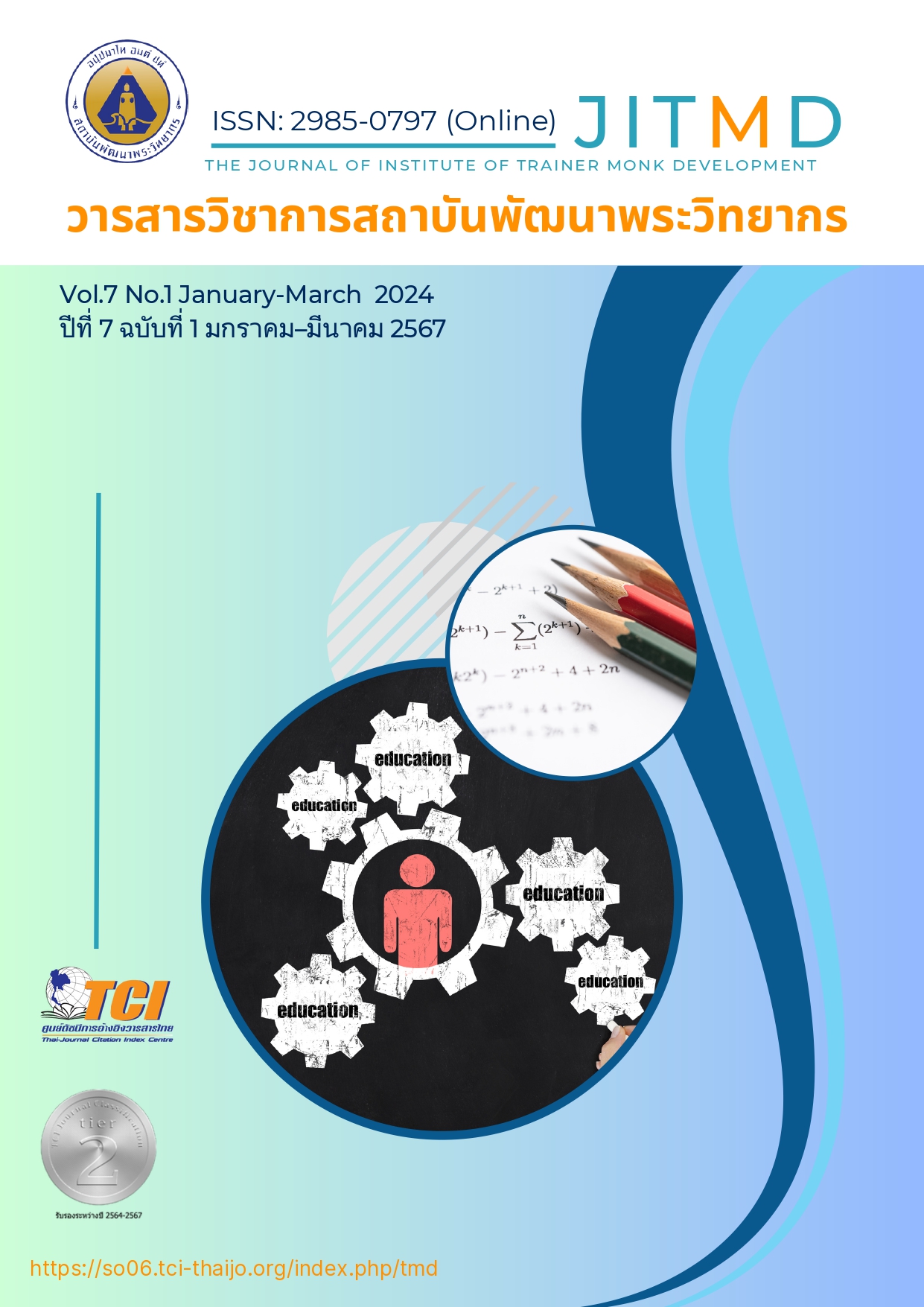The Effect of Developing Creative Thinking Skills on Natural Disasters and the Greenhouse Effect of Grade 6 Students Using the Modeling Activity Model Based on the Concept of STEM Education
Main Article Content
Abstract
The objectives of this research were 1) develop creative thinking skills on natural disasters and the greenhouse effect of grade 6 students using the modeling activity model based on the concept of STEM education 2) study the satisfaction of students towards modeling activity model based on the concept of STEM education. The sample group used in the research was grade 6 students in the second semester of the academic year 2022 at a school in Phra Nakhon Si Ayutthaya Province, totaling 41 students. The research tools consisted of 1) a lesson plan based on the concept of STEM education, 2) a creativity skill assessment form and 3) a satisfaction of students towards modeling activity model based on the concept of STEM education. The statistics used in data analysis were mean, percentage, and standard deviation. The results showed that 1) students had overall creative thinking skills at a high level with an average of 2.46, representing 81.99 percent, and a standard deviation of 0.16 and having the most creative thinking skills in designing and creating pieces with a mean of 2.83, percentage 94.33, and a standard deviation of 0.11 2) The students' satisfaction towards modeling activity model based on the concept of STEM education was at a high level with a mean of 4.33, percentage 86.59, and a standard deviation of 0.81.
Article Details

This work is licensed under a Creative Commons Attribution-NonCommercial-NoDerivatives 4.0 International License.
บทความที่ได้รับการตีพิมพ์เป็นลิขสิทธิ์ของวารสารวิชาการสถาบันพัฒนาพระวิทยากร
ข้อความที่ปรากฎอยู่ในบทความที่ได้รับการตีพิมพ์ในวารสาร ถือเป็นความรับผิดชอบของผู้เขียนบทความ และข้อคิดเห็นนั้นไม่ถือว่าเป็นทัศนะและความรับผิดชอบของกองบรรณาธิการวารสารวิชาการสถาบันพัฒนาพระวิทยากร
References
กระทรวงศึกษาธิการ. (2551). หลักสูตรแกนกลางการศึกษาขั้นพื้นฐานกลุ่มสาระการเรียนรู้วิทยาศาสตร์ พุทธศักราช 2551. กรุงเทพฯ: องค์การรับส่งสินค้าและพัสดุภัณฑ์ (ร.ส.พ.).
ชยพัทธ์ นาคกุลบุตร. (2565). การพัฒนาการคิดวิเคราะห์และความคิดสร้างสรรค์โดยการจัดการเรียนรู้ตามรูปแบบสะเต็มศึกษา. วารสารศึกษาศาสตร์มหาวิทยาลัยศิลปากร, 20(1): 241-256.
ชาญณรงค์ พรรุ่งโรจน์. (2546). ความคิดสร้างสรรค์. กรุงเทพฯ: โรงพิมพ์จุฬาลงกรณ์มหาวิทยาลัย.
วงค์ณภา แก้วไกรษร และนันทรัตน์ แก้วไกรษร. (2561). การพัฒนาทักษะการคิดสร้างสรรค์ของนักเรียนชุมนุมหุ่นยนต์เพื่อการเรียนรู้โดยใช้กิจกรรมการเรียนรู้ตามแนวทางสะเต็มศึกษา (STEM Education) ภายใต้หัวข้อหุ่นยนต์ทางเลือกแห่งอนาคต. โครงการวิจัยและพัฒนานวัตกรรมแลกเป้า สพฐ. ปีงบประมาณ 2561.
วิชัย วงษ์ใหญ่ และมารุต พัฒพล. (2564). การพัฒนาความคิดสร้างสรรค์ของผู้เรียน. กรุงเทพฯ: โรงพิมพ์บัณฑิตวิทยาลัย มหาวิทยาลัยศรีนตรินทรวิโรฒ.
สำนักงานรับรองมาตรฐานและประเมินคุณภาพการศึกษา (องค์การมหาชน). (2561). รายงานสรุปผลการประเมินคุณภาพภายนอกรอบสาม (พ.ศ.2554-2558). สืบค้นข้อมูลเมื่อวันที่ 8 กรกฎาคม 2566 จาก http://www.onesqa.or.th/th/download/906/
อภิญญา สิงห์โต. (2563). การพัฒนากิจกรรมการเรียนรู้แบบสะเต็ม ศึกษาที่ส่งเสริมความสามารถในการคิดแก้ปัญหาสำหรับนักเรียนชั้นมัธยมศึกษาปีที่ 1. การค้นคว้าอิสระ สาขาวิชาหลักสูตรและการสอน. มหาวิทยาลัยนเรศวร.
อนุพงศ์ ไพรศรี และคณะ. (2565). การสร้างและใช้แบบจำลองในห้องเรียนวิทยาศาสตร์. วารสารศึกษาศาสตร์ มหาวิทยาลัยนเรศวร, 24(1): 349-358.
อนุสรา พุ่มพิกุล. (2562). ผลของการจัดการเรียนรู้ตามแนวทางสะเต็มศึกษาโดยใช้ปัญหาเป็นฐานที่เน้นกระบวนการคิดอย่างมีวิจารณญาณที่มีต่อสมรรถนะการออกแบบวิธีการแก้ปัญหาผลสัมฤทธิ์ทางการเรียน และความพึงพอใจของนักเรียนชั้นมัธยมศึกษาปีที่ 1. วิทยานิพนธ์มหาบัณฑิต สาขาวิชาหลักสูตรและการสอน. มหาวิทยาลัยศรีนครินทรวิโรฒ.
Gilbert, J. K. (2004). Models and modelling: Routes to more authentic science education. International Journal of Science and Mathematics Education, (2)(2): 115-130.
National Research Council (NRC). (2012). Sustainable water and environmental management in the California Bay-Delta. Washington, D.C.: National Academies Press.


